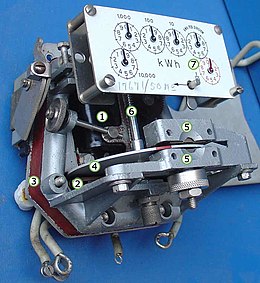Ferraris counter
The Ferraris meter , named after Galileo Ferraris , or induction meter is an electromechanical measuring device for electrical energy, colloquially an electricity meter , which is used to display the electrical energy consumed, and rarely also fed in, in the case of single or multi-phase alternating voltage in low-voltage networks. It consists of a special form of asynchronous motor , the Ferrari rotor , which has the shape of a circular aluminum disc, in connection with a mechanical counter .
construction
The Ferrari rotor is a rotatably mounted aluminum disc that runs through the alternating fields of two excitation coils. One coil is designed as a current path with very few turns, the other as a voltage path with a large number of turns and high impedance . The electrical current flowing through the consumer also flows through the coil in the current path, the electrical voltage (mains voltage) is applied to the coil in the voltage path . The torque exerted on the disk by the magnetic fields is always proportional to the product of current and voltage. In multi-phase systems , each outer conductor requires its own coil in the current and voltage path, the fields of which add up.
The cores of the coils of the current or voltage path are arranged on the aluminum disc in such a way that they together generate a rotating magnetic field which drives the disc via eddy currents induced in it, like an asynchronous motor. Due to the geometric arrangement of the coils and the fact that the phase angle in the voltage path is shifted by 90 ° due to the inductance, the torque is always proportional to the product of current strength and voltage, i.e. to the electrical active power . For adjustment, the correct phase shift in the voltage path can be set as part of the calibration on the meter. The reactive power then does not lead to any torque on average over time and is not counted. In addition, there are often short-circuit clips made of resistance wire with which the torque can be adjusted for different power levels.
The Ferraris meter only works correctly if the mains frequency is constant and the speed of the disk is much lower than that of the traveling field. Furthermore, there must be a braking torque proportional to the speed so that the integral of the instantaneous power (torque) over time is the number of revolutions per amount of energy. The braking torque is achieved by an eddy current brake with a permanent magnet , through whose field the disk also moves. The friction caused by the counter and the bearings must be compensated for by an auxiliary torque so that the speed of the disk is proportional to the driving torque of the traveling field or to the active electrical power. For this purpose z. B. the voltage coil made asymmetrical by a metal screw or a copper bracket, so that an independent traveling field is created. In order to ensure that the counter stops when no real power is being drawn, the axis of the counting disc has an inhibiting flag, which is attracted by a counterpart on the stationary parts, so that the disc comes to a standstill if a certain minimum power is not reached. Until the rest position is reached, the disc can run both forwards and backwards, although no current is consumed. If the (mostly red) marking on the disk can be seen in the middle of the meter's window when the machine is idling, the disk must stop - otherwise the meter is considered defective.
The Ferrari rotor drives a roller counter via a worm drive , which shows the number of disc revolutions as energy ( kilowatt hours ).
When electrical energy is fed back into the grid, a Ferraris meter normally runs backwards, provided there are no mechanical locks.
Ferraris meters are sensitive to position and can only be operated correctly when the aluminum disc is in a horizontal position.
For higher currents, the current coil is connected via a current transformer , for higher voltages the voltage coil is connected to a voltage transformer . For the measurement of reactive power , the phase of the current through the voltage coil, e.g. B. by a bumblebee circuit , rotated by 90 °.
Within the EU , according to the third EU internal market package, it is regulated that the electromechanical Ferraris meters must be replaced by 80% of all households by electronic energy meters with the option of remote reading by 2020 .
literature
- PM Pflier: Electricity meter. Tariff devices, transducers, time switches. A book for meter professionals . 1st edition. Springer, Berlin et al. 1954.
Individual evidence
- ↑ M. Stöckl, KH Winterling: Electrical measurement technology . 6th edition. Teubner, Stuttgart 1978, page 71 .
- ^ Peter Bastian et al.: Electrical engineering . 18th edition. Europa-Lehrmittel, Haan-Gruiten 1990, page 338 .
- ↑ Physikalisch-Technische Bundesanstalt: 7 first help rules for meter worries , page 2
- ↑ Right ( page no longer available , search in web archives ) Info: The link was automatically marked as defective. Please check the link according to the instructions and then remove this notice. accessed on the Wienenergie portal on December 15, 2017

